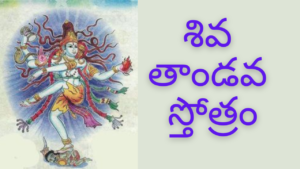Dwadasa Jyotirlinga Stotram in Telugu : The Dwadasa Jyotirlinga Stotram is a devotional hymn dedicated to the twelve Jyotirlingas, which are sacred shrines of Lord Shiva spread across India.
ద్వాదశ జ్యోతిర్లింగ స్తోత్రం
లఘు స్తోత్రం
సౌరాష్ట్రే సోమనాధంచ శ్రీశైలే మల్లికార్జునమ్ ।
ఉజ్జయిన్యాం మహాకాలం ఓంకారేత్వమామలేశ్వరమ్ ॥
పర్ల్యాం వైద్యనాధంచ ఢాకిన్యాం భీమ శంకరమ్ ।
సేతుబంధేతు రామేశం నాగేశం దారుకావనే ॥
వారణాశ్యాంతు విశ్వేశం త్రయంబకం గౌతమీతటే ।
హిమాలయేతు కేదారం ఘృష్ణేశంతు విశాలకే ॥
ఏతాని జ్యోతిర్లింగాని సాయం ప్రాతః పఠేన్నరః ।
సప్త జన్మ కృతం పాపం స్మరణేన వినశ్యతి ॥
సంపూర్ణ స్తోత్రం
సౌరాష్ట్రదేశే విశదేఽతిరమ్యే జ్యోతిర్మయం చంద్రకళావతంసమ్ ।
భక్తప్రదానాయ కృపావతీర్ణం తం సోమనాథం శరణం ప్రపద్యే ॥ 1 ॥
శ్రీశైలశృంగే వివిధప్రసంగే శేషాద్రిశృంగేఽపి సదా వసంతమ్ ।
తమర్జునం మల్లికపూర్వమేనం నమామి సంసారసముద్రసేతుమ్ ॥ 2 ॥
అవంతికాయాం విహితావతారం ముక్తిప్రదానాయ చ సజ్జనానామ్ ।
అకాలమృత్యోః పరిరక్షణార్థం వందే మహాకాలమహాసురేశమ్ ॥ 3 ॥
కావేరికానర్మదయోః పవిత్రే సమాగమే సజ్జనతారణాయ ।
సదైవ మాంధాతృపురే వసంతం ఓంకారమీశం శివమేకమీడే ॥ 4 ॥
పూర్వోత్తరే ప్రజ్వలికానిధానే సదా వసం తం గిరిజాసమేతమ్ ।
సురాసురారాధితపాదపద్మం శ్రీవైద్యనాథం తమహం నమామి ॥ 5 ॥
యం డాకినిశాకినికాసమాజే నిషేవ్యమాణం పిశితాశనైశ్చ ।
సదైవ భీమాదిపదప్రసిద్ధం తం శంకరం భక్తహితం నమామి ॥ 6 ॥
శ్రీతామ్రపర్ణీజలరాశియోగే నిబధ్య సేతుం విశిఖైరసంఖ్యైః ।
శ్రీరామచంద్రేణ సమర్పితం తం రామేశ్వరాఖ్యం నియతం నమామి ॥ 7 ॥
యామ్యే సదంగే నగరేఽతిరమ్యే విభూషితాంగం వివిధైశ్చ భోగైః ।
సద్భక్తిముక్తిప్రదమీశమేకం శ్రీనాగనాథం శరణం ప్రపద్యే ॥ 8 ॥
సానందమానందవనే వసంతం ఆనందకందం హతపాపబృందమ్ ।
వారాణసీనాథమనాథనాథం శ్రీవిశ్వనాథం శరణం ప్రపద్యే ॥ 9 ॥
సహ్యాద్రిశీర్షే విమలే వసంతం గోదావరితీరపవిత్రదేశే ।
యద్దర్శనాత్ పాతకం పాశు నాశం ప్రయాతి తం త్ర్యంబకమీశమీడే ॥ 10 ॥
మహాద్రిపార్శ్వే చ తటే రమంతం సంపూజ్యమానం సతతం మునీంద్రైః ।
సురాసురైర్యక్ష మహోరగాఢ్యైః కేదారమీశం శివమేకమీడే ॥ 11 ॥
ఇలాపురే రమ్యవిశాలకేఽస్మిన్ సముల్లసంతం చ జగద్వరేణ్యమ్ ।
వందే మహోదారతరస్వభావం ఘృష్ణేశ్వరాఖ్యం శరణం ప్రపద్యే ॥ 12 ॥
జ్యోతిర్మయద్వాదశలింగకానాం శివాత్మనాం ప్రోక్తమిదం క్రమేణ ।
స్తోత్రం పఠిత్వా మనుజోఽతిభక్త్యా ఫలం తదాలోక్య నిజం భజేచ్చ ॥
Table of Contents
Exploring the Dwadasa Jyotirlinga Stotram in Telugu: A Spiritual Journey
Introduction
The Dwadasa Jyotirlinga Stotram in Telugu holds a significant place in Hindu spirituality, particularly for devotees of Lord Shiva. In Telugu-speaking regions, this sacred hymn is deeply revered, reflecting the cultural and religious ethos of the community. This article delves into the significance, recitation, and benefits of the Dwadasa Jyotirlinga Stotram in Telugu, providing a comprehensive guide for those interested in this spiritual practice.
What is Dwadasa Jyotirlinga Stotram?
The Dwadasa Jyotirlinga Stotram is a devotional hymn dedicated to the twelve Jyotirlingas, which are sacred shrines of Lord Shiva spread across India. These Jyotirlingas are believed to represent different aspects of Shiva’s divine power and presence. The term “Dwadasa” means twelve, and “Jyotirlinga” refers to the radiant symbols of Shiva.
This stotra (hymn) praises and venerates each of the twelve Jyotirlingas, highlighting their divine attributes and the significance of each location. In Telugu, the hymn is rendered to fit the linguistic nuances, making it accessible to Telugu-speaking devotees.
The Twelve Jyotirlingas
The twelve Jyotirlingas are:
- Somnath (Prabhas Patan near Veraval, Saurashtra)
- Mallikarjuna (Srisailam in Andhra Pradesh)
- Mahakaleshwar (Ujjain in Madhya Pradesh)
- Omkareshwar (Khandwa in Madhya Pradesh)
- Kedarnath (Kedarnath in Uttarakhand)
- Bhimeashwar (Bhimashankar in Maharashtra)
- Kashi Vishwanath (Varanasi in Uttar Pradesh)
- Trimbakeshwar (Trimbak in Maharashtra)
- Vaidyanath (Vaijnath in Jharkhand or Vaidyanath in Maharashtra, as debated)
- Ramanath (Rameswaram in Tamil Nadu)
- Nageshwar (Aundha Nagnath in Maharashtra or Dwarka in Gujarat)
- Dharalinga (Dharalinga in Karnataka)
Each of these Jyotirlingas is considered to be a manifestation of Lord Shiva and is associated with various legends and mythological stories.
Importance of Reciting Dwadasa Jyotirlinga Stotram Telugu
Reciting the Dwadasa Jyotirlinga Stotram holds profound significance for devotees:
- Spiritual Connection: It helps devotees connect with the divine essence of Lord Shiva. The recitation in one’s native language makes the experience more personal and spiritually enriching.
- Cultural Relevance: For Telugu-speaking devotees, reciting the stotra in Telugu maintains cultural continuity and honors linguistic heritage.
- Understanding and Impact: Understanding the hymn in a familiar language ensures that the devotion is heartfelt and meaningful, enhancing its spiritual impact.
- Religious Practices: Incorporating the recitation into daily worship or special rituals strengthens one’s faith and devotion towards Lord Shiva.
How to Recite Dwadasa Jyotirlinga Stotram in Telugu
To effectively recite the Dwadasa Jyotirlinga Stotram in Telugu, follow these steps:
- Find a Peaceful Space: Choose a quiet and clean space for your recitation. A sacred environment enhances focus and spiritual connection.
- Prepare Mentally: Engage in a brief meditation or relaxation technique to clear your mind and prepare spiritually for the recitation.
- Use a Text: Obtain a copy of the Dwadasa Jyotirlinga Stotram in Telugu. Many versions are available online and in print.
- Correct Pronunciation: Ensure you pronounce the Telugu verses correctly. If necessary, listen to recordings or consult knowledgeable individuals.
- Regular Practice: Incorporate the recitation into your daily or weekly spiritual practices to deepen your connection with Lord Shiva.
Benefits of Dwadasa Jyotirlinga Stotram
Reciting the Dwadasa Jyotirlinga Stotram offers numerous benefits:
- Spiritual Upliftment: It fosters a deeper spiritual connection with Lord Shiva, leading to inner peace and enlightenment.
- Blessings and Prosperity: Devotees believe that regular recitation can bring blessings, prosperity, and protection from negative influences.
- Mental Clarity: The rhythmic recitation helps calm the mind and improves mental clarity and focus.
- Cultural Heritage: Engaging with this stotra in Telugu preserves and promotes the cultural and religious heritage of the Telugu-speaking community.
FAQs
What is the significance of the Dwadasa Jyotirlinga Stotram?
The Dwadasa Jyotirlinga Stotram is a devotional hymn that praises the twelve sacred Jyotirlingas of Lord Shiva. Each Jyotirlinga represents a unique aspect of Shiva’s divine presence, and reciting the stotra helps devotees connect spiritually with these sacred sites.
Why is the Dwadasa Jyotirlinga Stotram recited in Telugu important?
Reciting the Jyotirlinga Stotram in Telugu is important as it allows Telugu-speaking devotees to engage deeply with their spiritual practice in their native language. This enhances understanding, devotion, and cultural relevance.
How can I find a copy of the Jyotirlinga Stotram
Copies of the Dwadasa Jyotirlinga Stotram in Telugu can be found in religious bookstores, online platforms, or through local temples. Many websites offer free downloadable versions or printed copies.
Can the Dwadasa Jyotirlinga Stotram be recited daily?
Yes, the Jyotirlinga Stotram can be recited daily as part of one’s spiritual practice. Regular recitation is believed to bring spiritual benefits and blessings from Lord Shiva.
What are the benefits of reciting the Dwadasa Jyotirlinga Stotram?
The benefits include spiritual upliftment, blessings, prosperity, mental clarity, and the preservation of cultural heritage. It helps devotees develop a deeper connection with Lord Shiva and enhances their devotional practice.
Are there any specific times recommended for reciting the Jyotirlinga Stotram?
While there are no strict rules, many devotees choose to recite the stotra during early morning hours (Brahma Muhurta) or during auspicious times such as Maha Shivaratri. The key is to recite it with devotion and sincerity.
Conclusion
The Dwadasa Jyotirlinga Stotram in Telugu is more than just a hymn; it is a spiritual journey that bridges linguistic heritage and divine devotion. By understanding and incorporating this stotra into daily practice, Telugu-speaking devotees can enhance their spiritual connection with Lord Shiva and honor their cultural traditions. Whether you are new to this practice or a seasoned devotee, the Dwadasa Jyotirlinga Stotram offers a profound way to engage with one of Hinduism’s most revered deities.























